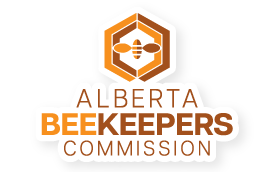MONITOR, MONITOR, MONITOR!!!
By Renata Borba, Tech Transfer Program Lead
When it comes to disease prevention and treatment, if you don’t know what you are fighting, you may be taking the wrong measures. It is very important to continuously monitor for diseases and manage them properly.
The year of 2019 was a challenging year for most beekeepers in Alberta. We saw an abnormally high number of EFB infections, and due to unfavourable weather conditions, many colonies struggled during the summer and did not fully recover. The biggest enemy to all beekeepers, the Varroa mite, did not stay behind. Some beekeepers reported high infestation rate and concerns were raised about chemical mite control treatments efficacy.

“Challenging time”. We are hearing these two words very often right now due to the current COVID pandemic, but honey bees have been in the midst of an epidemic for several years! Varroa mites feed on honey bees’ fat body (a tissue that concentrates and stores fat, protein and sugars – the main nutritional resource for bees during the winter) and transmit a variety of viruses to other bees within the colony and to neighboring colonies. The prevalence of Varroa and its associated viruses has reached epidemic proportions and is the leading cause of honey bee colony mortality. For this reason, Varroa management must be taken seriously and become a regular part of your honey bee management plan.
Take actions. Monitor your hives for Varroa levels. It’s simple and fairly quick to sample a hive for mites. There are several methods you can use, but the most widely used field assessment methods for mites are the “sugar roll” and “alcohol wash” methods (check out our TTP webpage for details on how to perform these two methods – www.albertabeekeepers.ca/tech-transfer-program). The chances that you WILL have mites in your hive this year are very high, but that does not mean that you will be losing every colony for mites. While a colony may be able to manage, tolerate and survive in the presence of mites, it’s the association of mites with viruses that will pose the highest threat to the colony. Varroa mites, when associated with viruses can pose a dangerous threat to the colony as it may be able to kill a colony at a lower threshold than it would in the absence of viruses. Most honey bee virus infections do not present visual signs of the disease, which precludes field diagnoses and allows viral infections to go unnoticed by beekeepers. Although it is simple for a beekeeper to measure mite loads in the field, assessment of viral levels is not simple and can be very costly. Several studies have linked viral infections to reductions in colony overwinter survival and bee lifespan, but due to the diagnostics cost and the labour involved, monitoring for viral levels is not a common practice in beekeeping operations.
What is the Tech Transfer Program doing to help? One of the services we launched this year is completely focused on disease monitoring. Our team is out on the road (and busy in the lab) checking colonies for visual signs of diseases and collecting samples for detection of Varroa mites, Nosema, EFB, AFB (including antibiotic resistance), and four viruses (Deformed Wing Virus, Varroa Destructor Virus, Sacbrood Virus and Acute Paralysis Virus). We will be returning to the same apiaries in the fall to collect another round of samples and check colonies once again for visual signs of diseases before colonies are wintered. Our goal is to increase beekeepers’ awareness to the diseases in their colonies and guide them in developing a management strategy to make sure that diseases are under control and that colonies stay healthy.

A composite sample of live bees are collected from 10 colonies in each apiary and shipped via Canada post to the National Bee Diagnostic Centre for disease diagnostics. Bees sampled for viral analysis must be shipped alive in order to preserve RNA integrity for viral testing. Live bees are shipped in boxes with queen candy and water.

The Tech Transfer Program is pleased to introduce our new apiculture technician Nicole McCormick! Through the remainder of the spring and into the summer and fall, Nicole will be assisting with colony health monitoring and sampling around the province, as well as assisting with laboratory work. To those of you who will have Nicole coming to your farm, please join us in extending a warm welcome to our new Tech Transfer Program technician!
Know your enemies. Familiarize yourself with the most common diseases, treatment measures and train your staff. A European study published in 2017 at PlosOne journal (10.1371/journal.pone.0172591) showed that “the main factors protecting honey bee colonies are the beekeeper background and practices”. This highlights the importance of promoting beekeeper training and good beekeeping practices to achieve early identification of clinical signs of disease. The second service launched by the Tech Transfer Program this year is on-site IPM training for seasonal staff. Unfortunately, due to COVID-19, this training was cancelled. This is upsetting news as we had been preparing for the last couple of months to provide this training, but we look forward to seeing you next year! Check out our website for some great online educational resources. If you have any questions, please feel free to contact me at renata.borba@albertabeekeepers.ca.
